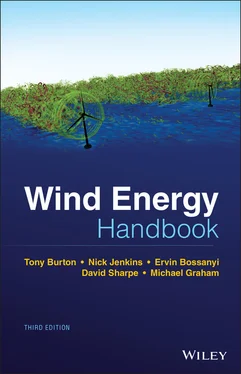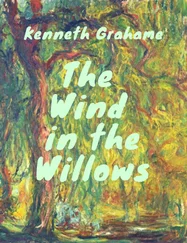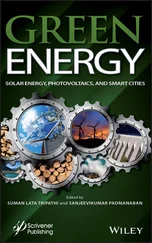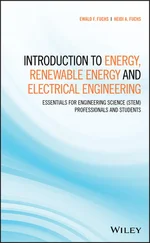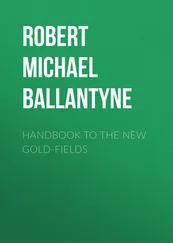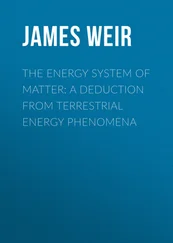1 Cover
2 Title Page Wind Energy Handbook Third Edition Tony Burton Wind Energy Consultant, London, UK Nick Jenkins Cardiff University, UK Ervin Bossanyi DNV GL, Bristol, UK David Sharpe Wind Energy Consultant, Essex, UK Michael Graham Imperial College, London, UK
3 Copyright
4 About the Authors
5 Preface to Second Edition
6 Preface to Third Edition
7 Acknowledgements for the First Edition
8 Acknowledgements for the Second Edition
9 Acknowledgements for the Third Edition
10 List of Symbols
11 Figures C1 and C2 – coordinate systems
12 1 Introduction1.1 Historical development of wind energy 1.2 Modern wind turbines 1.3 Scope of the book References Websites Further Reading
13 2 The wind resource 2.1 The nature of the wind 2.2 Geographical variation in the wind resource 2.3 Long‐term wind speed variations 2.4 Annual and seasonal variations 2.5 Synoptic and diurnal variations 2.6 Turbulence 2.7 Gust wind speeds 2.8 Extreme wind speeds 2.9 Wind speed prediction and forecasting 2.10 Turbulence in complex terrain References
14 3 Aerodynamics of horizontal axis wind turbinesAuthor's note on aerodynamics 3.1 Introduction 3.2 The actuator disc concept 3.3 Rotor disc theory 3.4 Vortex cylinder model of the actuator disc 3.5 Rotor blade theory (blade‐element/momentum theory) 3.6 Actuator line theory, including radial variation 3.7 Breakdown of the momentum theory 3.8 Blade geometry 3.9 The effects of a discrete number of blades 3.10 Stall delay 3.11 Calculated results for an actual turbine 3.12 The performance curves 3.13 Constant rotational speed operation 3.14 Pitch regulation 3.15 Comparison of measured with theoretical performance 3.16 Estimation of energy capture 3.17 Wind turbine aerofoil design 3.18 Add‐ons (including blade modifications independent of the main structure) 3.19 Aerodynamic noise References Websites Further Reading Appendix A3 Lift and drag of aerofoils Note
15 4 Further aerodynamic topics for wind turbines4.1 Introduction 4.2 The aerodynamics of turbines in steady yaw 4.3 Circular wing theory applied to a rotor in yaw4.4 Unsteady flow 4.5 Unsteady aerofoil aerodynamics 4.6 Dynamic stall 4.7 Computational fluid dynamics References Further Reading Note
16 5 Design loads for HAWTs5.1 National and international standards 5.2 Basis for design loads 5.3 Turbulence and wakes5.4 Extreme loads 5.5 Fatigue loading 5.6 Stationary blade loading5.7 Blade loads during operation 5.8 Blade dynamic response 5.9 Blade fatigue stresses 5.10 Hub and low‐speed shaft loading5.11 Nacelle loading 5.12 Tower loading 5.13 Wind turbine dynamic analysis codes 5.14 Extrapolation of extreme loads from simulations References Appendix A5 Dynamic response of stationary blade in turbulent wind References
17 6 Conceptual design of horizontal axis wind turbines6.1 Introduction 6.2 Rotor diameter 6.3 Machine rating 6.4 Rotational speed 6.5 Number of blades 6.6 Teetering 6.7 Power control6.8 Braking systems 6.9 Fixed‐speed, two‐speed, variable‐slip, and variable‐speed operation 6.10 Other drive trains and generators6.11 Drive train mounting arrangement options 6.12 Drive train compliance 6.13 Rotor position with respect to tower 6.14 Tower stiffness 6.15 Multiple rotor structures 6.16 Augmented flow 6.17 Personnel safety and access issues References Note
18 7 Component design 7.1 Blades 7.2 Pitch bearings 7.3 Rotor hub 7.4 Gearbox7.5 Generator 7.6 Mechanical brake 7.7 Nacelle bedplate 7.8 Yaw drive 7.9 Tower 7.10 Foundations References
19 8 The controller 8.1 Functions of the wind turbine controller8.2 Closed‐loop control: issues and objectives 8.3 Closed‐loop control: general techniques 8.4 Closed‐loop control: analytical design methods 8.5 Pitch actuators 8.6 Control system implementation References
20 9 Wake effects and wind farm control9.1 Introduction 9.2 Wake characteristics 9.3 Active wake control methods 9.4 Wind farm control and the grid system References
21 10 Onshore wind turbine installations and wind farms 10.1 Project development 10.2 Landscape and visual impact assessment 10.3 Noise 10.4 Electromagnetic interference 10.5 Ecological assessment References Software Notes
22 11 Wind energy and the electric power system11.1 Introduction 11.2 Wind turbine electrical systems 11.3 Wind farm electrical systems 11.4 Connection of wind farms to distribution networks 11.5 Grid codes and the connection of large wind farms to transmission networks 11.6 Wind energy and the generation system 11.7 Power quality References Appendix A11 Simple calculations for the connection of wind turbines Notes
23 12 Offshore wind turbines and wind farms12.1 Offshore wind farms 12.2 The offshore wind resource 12.3 Design loads 12.4 Machine size optimisation 12.5 Reliability of offshore wind turbines 12.6 Fixed support structures – overview 12.7 Fixed support structures 12.8 Floating support structures 12.9 Environmental assessment of offshore wind farms 12.10 Offshore power collection and transmission systems References Appendix A12 Costs of electricity Note
24 Index
25 End User License Agreement
1 Chapter 2 Table 2.1 Typical surface roughness lengths.
2 Chapter 3 Table 3.1 Summary of Ronsten's measurements of lift coefficient and lift coef... Table 3.2 Blade design of a 17 m diameter rotor. Table 3.3 Summary of the NREL aerofoils and their applications. Table 3.4 The principal characteristics of the Risø‐A series. Table 3.5 The principal characteristics of the Risø‐P series. Table 3.6 The principal characteristics of the Risø‐B series. Table 3.7 The principal characteristics of the Delft University series.
3 Chapter 5Table 5.1 Wind speed parameters for wind turbine classes.Table 5.2 Partial safety factors for loads, IEC 61400‐1 edition 4.Table 5.3 Partial safety factors for the consequences of failure, IEC 61400‐1...Table 5.4 Extreme values of random component for different exposure times.Table 5.5 Values of first mode structural damping logarithmic decrements for ...Table 5.6 SC40 blade damping ratios for first two flapwise modes.Table 5.7 Comparison between nacelle moments due to deterministic loads for t...Table 5.8 Example M Xand M Yfatigue spectra.Table 5.9 Joint M Xand M Ycycle distribution.Table 5.10 Table of mean values of the reduced variate, y ν= −ln[−ln(F(xTable 5.11 Table of confidence bounds on the number of simulations in which t...
4 Chapter 6Table 6.1 Component costs expressed as a percentage of total machine cost for...Table 6.2 Component costs and percentages for NREL 1.5 MW 70 m diameter basel...Table 6.3 Percentage contribution of different components to machine cost for...Table 6.4 Variation of optimum rated wind speed with annual mean for 70 m dia...Table 6.5 Contribution of different components to the cost of a two bladed ma...Table 6.6 Comparison of two bladed design variants on a 70 m diameter, 1.5 MW...Table 6.7 Comparison of loads on shaft and nacelle for three bladed and rigid...Table 6.8 Main parameters of a 3 MW, 15 rpm radial flux generator designTable 6.9 Superconducting materials suitable for wind turbine generatorsTable 6.10 Cost comparison between a 126 m diameter turbine and an array of 1...Table 6.11 Cost comparison between a 126 m diameter turbine and an array of 1...
5 Chapter 7Table 7.1 Structural properties of materials for wind turbine bladesTable 7.2 Compositions and properties of E‐glass, R‐glass, and H‐glassTable 7.3 Typical matrix propertiesTable 7.4 Comparison of 10 6cycle maximum tensile strains in laminates with h...Table 7.5 Comparison of 10 6cycle maximum tensile strains in laminates with e...Table 7.6 Comparison of 10 6cycle maximum tensile strains in aligned strand a...Table 7.7 Properties of two PAN carbon fibres used in composites for wind tur...Table 7.8 Comparison between GFRP UD laminate mechanical properties and CFRP ...Table 7.9 Properties of unjointed wood/epoxy laminatesTable 7.10 Partial material factors for composite bladesTable 7.11 Design strength to stiffness ratios for different wind turbine bla...Table 7.12 Illustrative increases in design torques for gear tooth bending du...Table 7.13 Illustrative example of calculation of brake disc temperature rise...Table 7.14 Recommended dimple tolerance and corresponding value of the fabric...
Читать дальше
